Director: Arthur Penn, Writers: David Newman, Robert Benton, Robert Towne
Stars
Warren Beatty – Clyde Barrow

Beatty was born in 1937 and had a career spanning six decades. He started his career appearing in TV shows in the 50s, before making his film debut in 1961’s Splendour In The Grass, and received overwhelming praise for his role, being nominated for a golden globe and received an award for best new actor of the year. He later appeared in films like Lilith (1964), alongside fellow Bonnie And Clyde star Gene Hackman, and Mickey 1 (1965). Bonnie And Clyde was the first film he produced, and originally wasn’t going to star in it, but when the other actors who were offered the role turned it down he decided to play the role himself.
Faye Dunaway – Bonnie Parker

Dunaway made her acting debut on Broadway, appearing in performances of Arthur Miller plays like The Crucible and After The Fall, as well as other performances. She performed in the award winning play Hogan’s Goat, directed by a man called William Alfred who became her mentor. Her first film role was crime comedy film The Happening (1967), as well as drama Hurry Sundown, also released in 1967. She was in a six-movie contract with the Hurry Sundown director Otto Preminger, but paid to end the contract after falling out with Otto during production. She was called in by Penn to read for Bonnie Parker after he saw her performance in The Happening, though she had auditioned for a role in one of his films but was turned away by a casting director a year prior. Beatty’s sister was originally going to play the role of Bonnie when he was just the producer, but the role had to be changed when he decided to play Clyde. Dunaway was up against a lot of competition, but Penn was able to convicne Beatty that she was right for the part. Bonnie And Clyde was only Dunaway’s 3rd movie.
Michael J. Pollard – C. W Moss
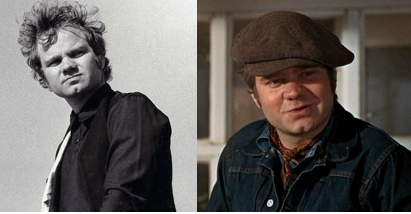
Pollard was born in 1939 and was an American character actor. He often played quirky, off-beat characters and had distinctive look, making him a “Cult Favourite” actor. He made his screen debuts in episodes of Alfred Hitchcock Presents, before making his film debut as an uncredited role in It Happened To Jane (1959). He went on to appear in films such as Hemmingway’s Adventures Of A Young Man (1962), Summer Magic (1963) and Gunsmoke (1964). He also appeared in an episode of Star Trek. In Bonnie And Clyde he plays C.W Moss, an original character for the film filling the roles of the two real life Barrow Gang members Henry Methvin and D.W Jones. Pollard fulfils his standard character role of a quirky, comedic character. He received a Golden Globe nomination for best supporting actor for this role, and won a BAFTA for “Most Promising Newcomer”. This role also led to his joke presidential candidacy in 1968, complete with a campaign song. He went on to appear in a variety of different films, like Scrooged (1988), as well as roles in low budget horror films like Sleepaway Camp III: Teenage Wasteland (1989), American Gothic (1988), and Rob Zombie’s House Of 1000 Corpses (2003). He died in 2019 of cardiac arrest.
Gene Hackman – Buck Barrow
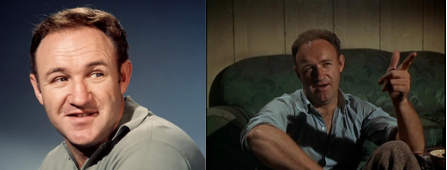
Hackman was a highly respected actor, considered one of the best of his generation. At 16 he lied about his age to join the army, first stationed in China then moved to Hawaii. He spent 4 and a half years in the army. He was discharged in 1951 and moved to New York. He persued a career in acting but was voted the least likely to succeed (along with friend Dustin Hoffman) by his peers in the Pasadena Playhouse. He performed small roles in television series and performed in off-Broadway shows. His first role was an uncredited role as a police officer in Mad Dog Coll (1961). Another early film role was Lilith (1964), which starred future Bonnie And Clyde co-star Warren Beatty. It was also his first credited role. He had a few small roles in TV and movies until Bonnie And Clyde in 1967, where he played a leading role as Clyde’s brother Buck Barrow, and didn’t become widely noticed until 1970 in his oscar nominated breakthrough role as Gene Garrison in I Never Sang For My Father. From there he gained more respect and became a successful actor, appearing in The French Revolution (1971) and Lex Luthor in Superman: The Movie (1978).
Estelle Parsons – Blanche Barrow

Parsons originally studied law before she became an actress, settling on acting in the 1950s. She was first a writer and producer on The Today Show, and performed in a lot of both on and off Broadway productions, earing awards for performances in Next Time I’ll Sing To You and In The Summer House, and made her film debut in 1963 with Ladybug Ladybug as JoAnne’s mother. In Bonnie And Clyde (1967), she portrays Blanche Barrow, Buck’s danger averse and often hysterical wife. It was only Parsons’ second film role, but she was awarded an Oscar for Best Supporting Actress, an impressive feat. She appeared in a few other film roles, but she was mainly a stage actor.
Denver Pyle – Frank Hamer

Pyle was an actor better known for his television roles than his film roles, appearing in series such as The Range Rider, Have Gun Will Travel, Frontier, Fury and Gunsmoke. The majority of his roles were in westerns, with Pyle usually playing a criminal or cowboy, though he also appeared in shows like The Adventures Of Superman and even an episode of The Twilight Zone. His first credited film role was Devil Ship (1947), and appeared in many more westerns like Red Canyon (1949), Hellfire (1949), Rebel City (1953), and The Man Who Shot Liberty Valence (1962). His frequent (and violent) roles in westerns is probably a large factor in his casting as vengeful cowboy-styled deputy Frank Hamer in Bonnie And Clyde.
Mise-En-Scene
Locations

Taking inspiration from the French New Wave, Bonnie And Clyde utilises on location filming in favour of the standard studio filming. For example, the scene where the gang torments Hamer was shot at Lemmon Lake, Dallas, Texas. The majority of the filming took place in Texas, as that is where the real life Bonnie and Clyde operated, adding to the effect of the on location filming.
Sets (Interior)
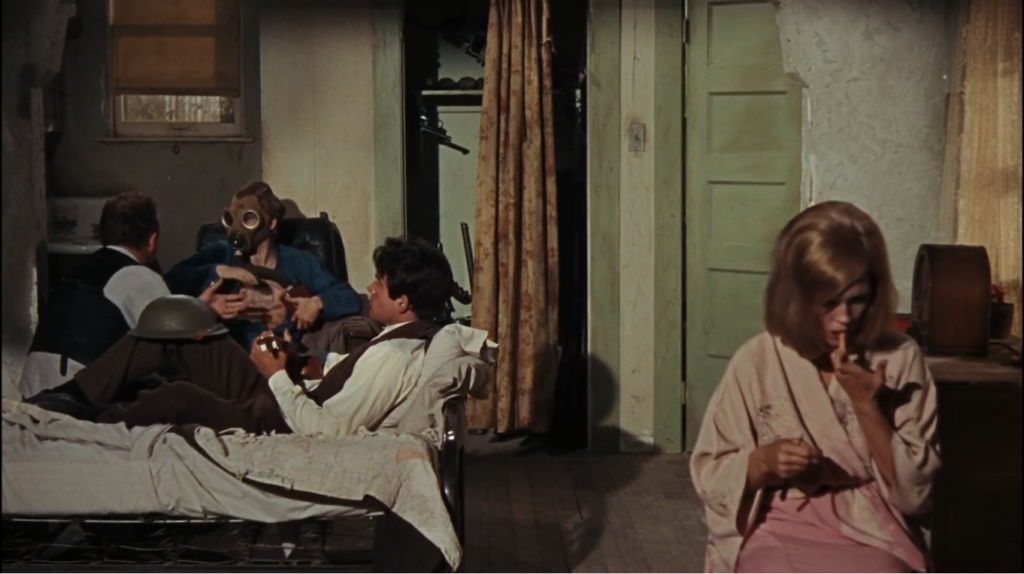
The interior sets are naturalistic but still designed. For example, this scene showing the Barrow Gang hiding out at the Tourist Court Motel, depicting a real thing that happened and a real place (though the real one was in Missouri and the sign in the film says Iowa), adding to the realism of the film. The room the gang stays in is clean and devoid of bags or personal belongings, the only things seeming to belong to the gang being the guns in the closet, the helmet and the gas mask, showing they don’t have many personal belongings and haven’t been in the room for long.
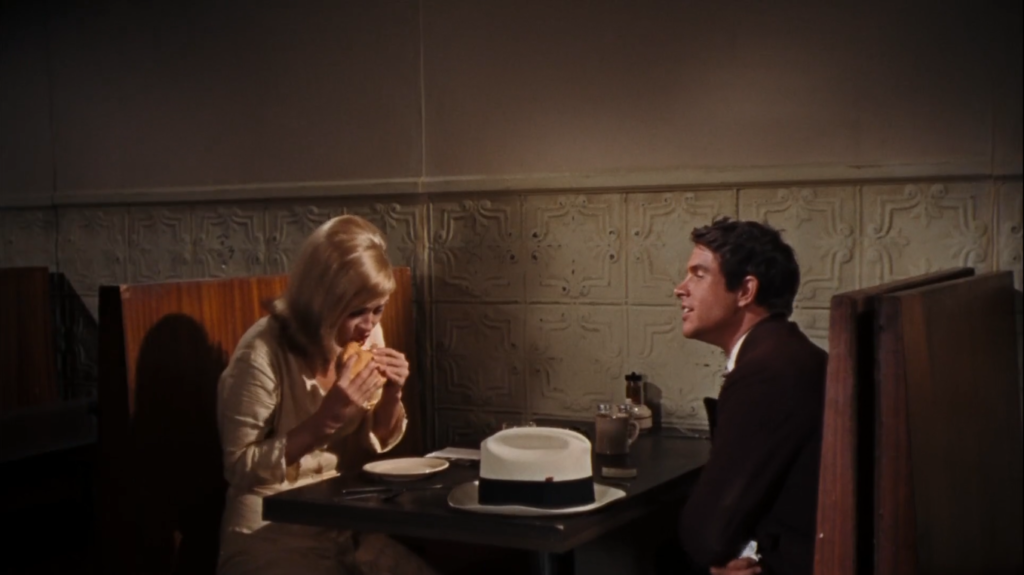
The café scene was shot on location, in Lavon State Bank in Texas. The location was probably used due to how stylish the place looked, the decorated wall and the wooden benches working with the style of the film.
Costume
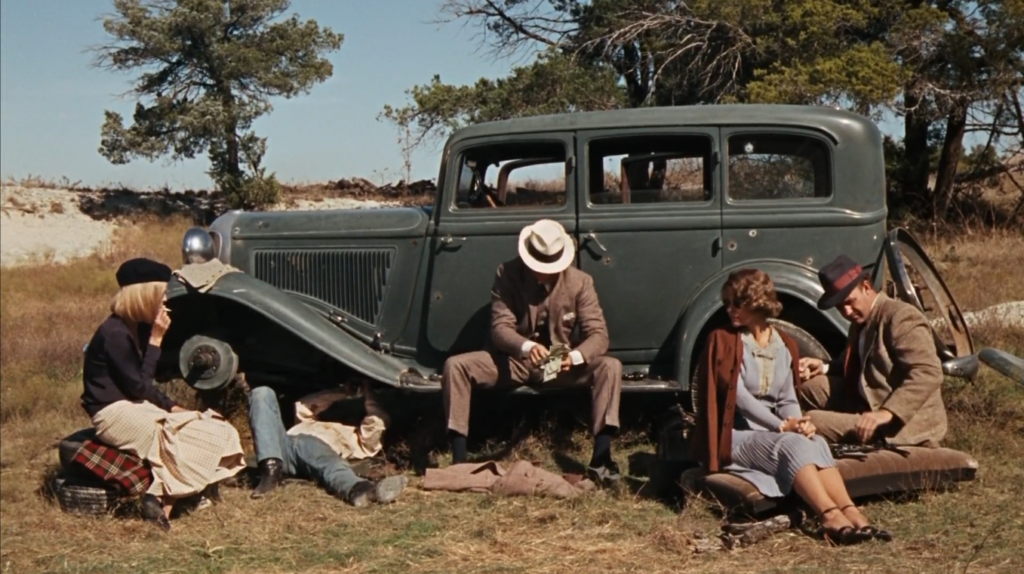
The Gangsters in Bonnie And Clyde dress in glamourous and stylish costumes. The Barrow brothers dress elegantly in suits, waistcoats and hats, possibly inspired by the fedora wearing suit-clad gangsters of the noir films Bonnie And Clyde takes inspiration from. Bonnie is the most notable in terms of costume, becoming a style icon of the time, influencing fashion of the late 60s, evoking elegance and 30’s influence. The costume serves to convey the sense of attraction and sexuality the film wanted to show, and what drew the people of the 30s to the pair of gangsters in the first place.

The antagonist of the film, Frank Hamer, contrasts the costume of the gangsters. While the Barrow Gang wears sleek, stylish outfits and care about looks, Hamer differs, wearing loose clothing and giving a more boxy silhouette than the slim clothes worm by the Gang. Hamer isn’t focused on attention or style, just the job and reputation. The larger stetson also contrasts the hats worn by the gangsters, like the Barrow’s fedoras and Bonnie’s beret.
Editing
The editing exemplifies the French New Wave influence and differs from the Warner Brothers “invisible editing” style greatly.


During this car chase scene, jump cuts are used in the middle of the action to show the differing views on the Barrow Gang. We are shown the car chase, scored with the up beat bluegrass chase music, which is fast paced and chaotic. But in the middle of the action, we jump forward in time to an interview with the police chief calling the Gang a menace and swearing to bring them to justice, before getting his picture taken for the paper. During this the bluegrass music abruptly cuts out. After he gets the picture taken the music comes back and we are taken back to the car chase. The chase is interrupted again with another jump cut forward to an interview with a civilian witness. The music suddenly cuts again as the witness says that the gang let him keep his money, and talks of them favourably, before we cut back to the car chase with the chaotic bluegrass music. This is an obvious example of how the editing style differs from classic Hollywood, as the sudden jump cuts break the immersion, which the “invisible editing” style wants to avoid.
Sound
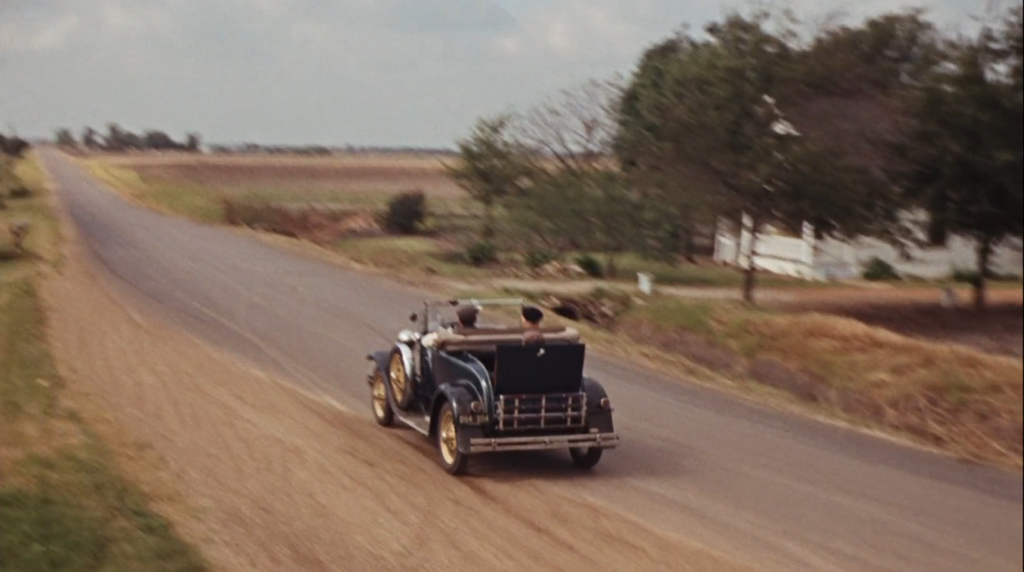
The film has a bluegrass focused soundtrack, specifically using song “Foggy Mountain Breakdown” by Flatt and Scruggs in scenes with action. The bluegrass introduces an excited, light hearted tone to the action, making the crimes committed by the gang seem fun. The bluegrass genre intones the south/Texas and an old time feeling (though bluegrass was more of a 1940s sound than ’30s). The bluegrass is non-diegetic and serves as a motif to the action scenes.
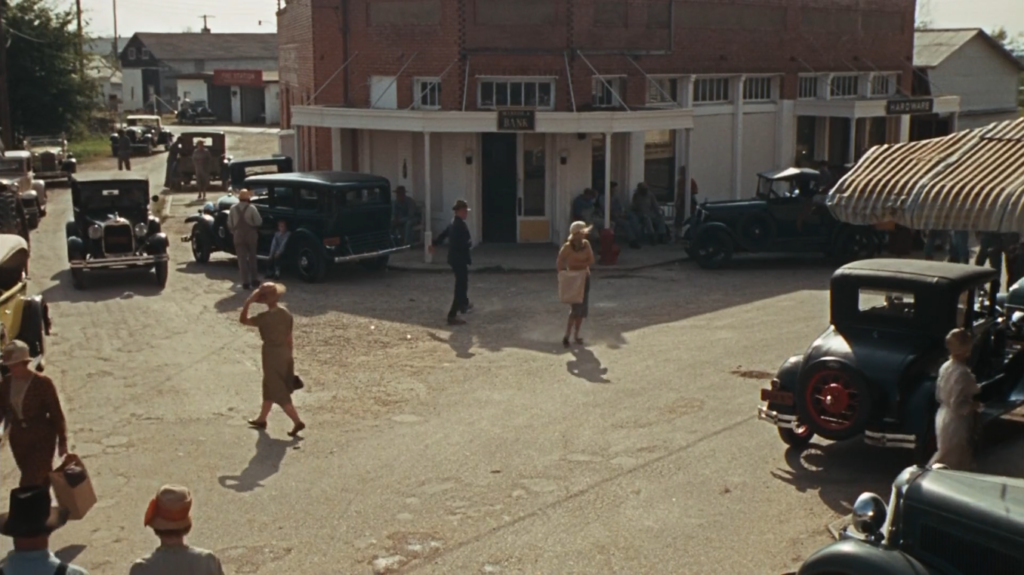
The film uses diegetic sound too, such as the alarm ringing after Bonnie and Clyde rob the bank.
Aesthetics
Realism

The film focuses on realism and historical accuracy, though it does greatly simplify the real story (C.W Moss being a composite of the real D.W Jones and Henry Methvin). The focus on on-location filming adds to the realism element, filming all around the north of Texas, close to the real places the criminals operated in. The film also depicts many real events, such as the taking of the iconic photo of Bonnie on the car (above), the final shooting of the couple (though the depiction is far less violent than the real life shooting) and the Tourist Court shootout. The film was also one of the first to feature extensive use of squibs to create realistic blood spurts when characters are shot. During the time Bonnie And Clyde was released in, gunshots were bloodless and painless, so the depiction of blood and pain when someone is shot was seen as very graphic for the time.
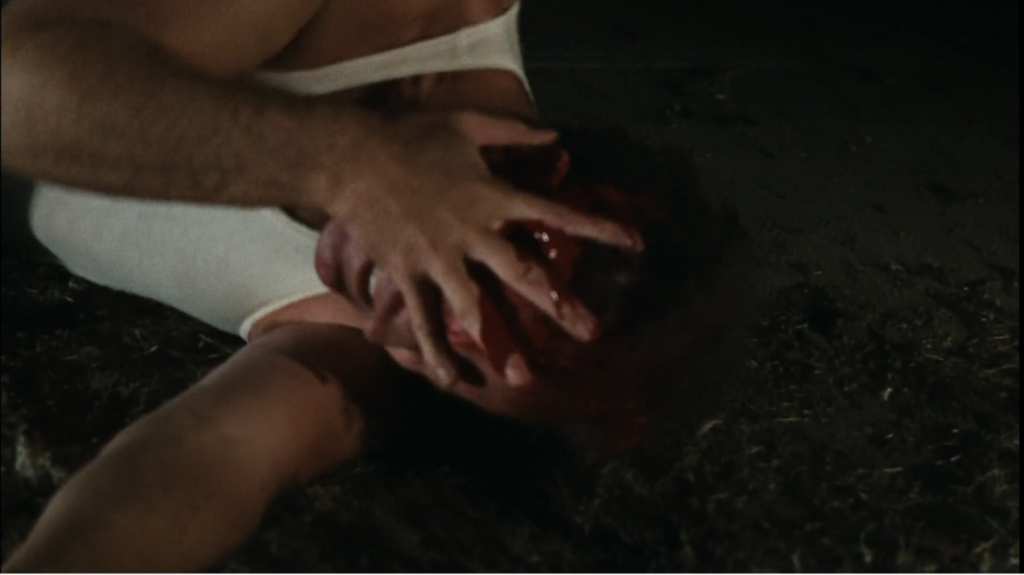
Tone
Bonnie and Clyde has a varying tone, some scenes being light hearted, some comedic, some scenes being romantic and others being very serious. Often the car chase scenes and the robberies being comedic and light hearted, scored with exciting music and showing the gang usually enjoying themselves. Some scenes are quite comedic, like when Clyde tries to get out of the car after telling Bonnie he has erectile dysfunction and banging his head on the doorframe, when he tries to rob the bank that went out of business due to the great depression and when Moss tries to show off his tattoo to his father. Bonnie and Clyde obviously feature in a lot of romantic scenes, where they banter and play off each other and flirt a lot. The film is also able to be serious however, in the shootout scenes and scenes featuring Hamer. The serious scenes often take place at night or not vibrant lighting, and don’t contain scoring, containing gunshots and cries of pain mostly.
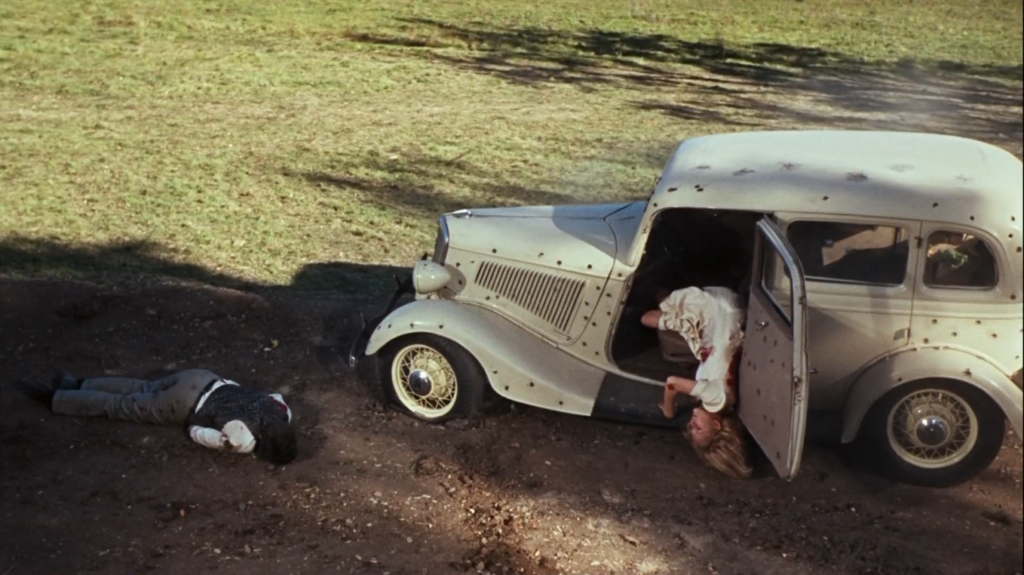
These tones are also able to play off each other to create mood, such as the end of the film, when the audience knows Hamer has tracked them down and will ambush them by the end of the film while the film shows us the couple enjoying themselves in the town. The film is able to balance these tones to make the light hearted, fun scenes don’t seem out of place with the more serious scenes.
Visual Style
The film takes a lot of inspiration from the French New Wave visually, making use of close-ups, jump cuts, camera angles, etc. to give scenes a dynamic feel and make the film engaging.
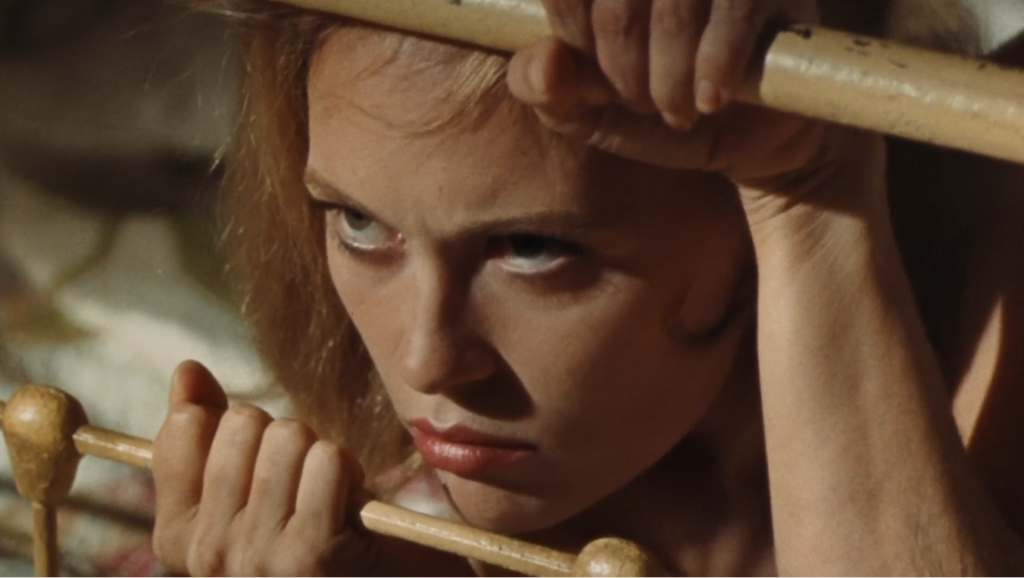
The opening scene with Bonnie in her room is a good example of the film’s visual style, starting with a close up on Bonnie’s lips, then panning to Bonnie in a mirror, then jump cutting to Bonnie standing up and walking to the bed, then jump cutting again to Bonnie lying down on the bed. The editing is erratic and involving, and the filming works to show the audience Bonnie’s character, using her head as a visual metaphor for Bonnie feeling trapped in a mundane life. This varies greatly from the generic wide shot and shot-reverse-shot that was very typical in Hollywood at the time.
Representation
Women

Bonnie Parker is atypical of women in film in the 1960’s. Bonnie is presented as an equal to Clyde, and is treated with respect by the film. She smokes, shoots, kills, does crime and wears stylish clothes. She is able to laugh at the male characters, has her own agency and personality, and Clyde supports her in her interests in poetry (sticking up for her when Buck doesn’t take it seriously) and allows her to see her family when she asks him to. The character presents the interest the real Bonnie Parker drew from the American public through her attitude not typical in women in the 30s, smoking cigars and robbing banks, acting freely.
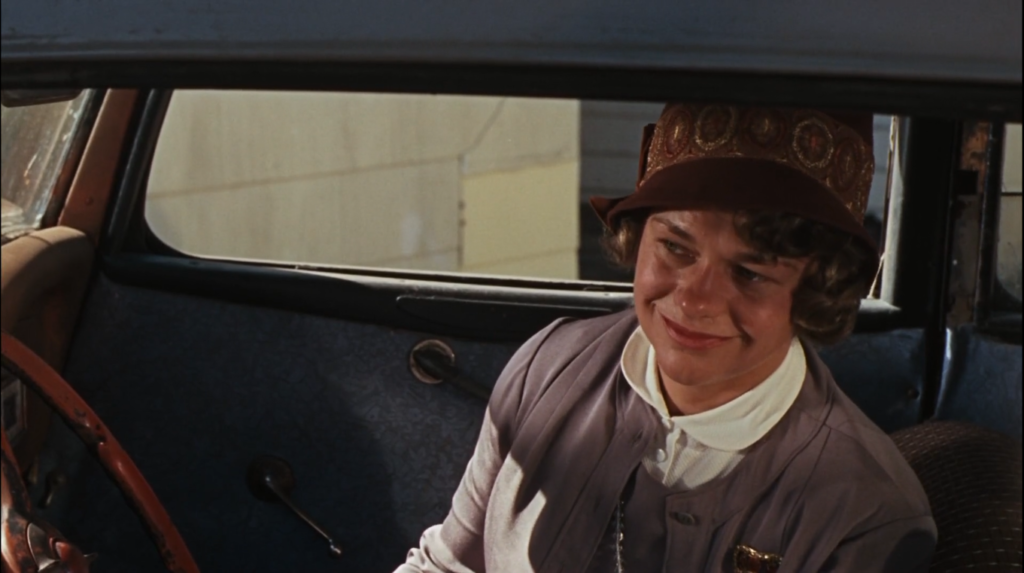
Contrasting this is Blanche, Buck’s wife. She is a more typical representation of women of the time, very hesitant to be involved in the Gang’s actions and very often hysterical. While the majority of Blanche’s character is stereotypical, she is given moments of independence, for example demanding a share of the money from Clyde.
Men
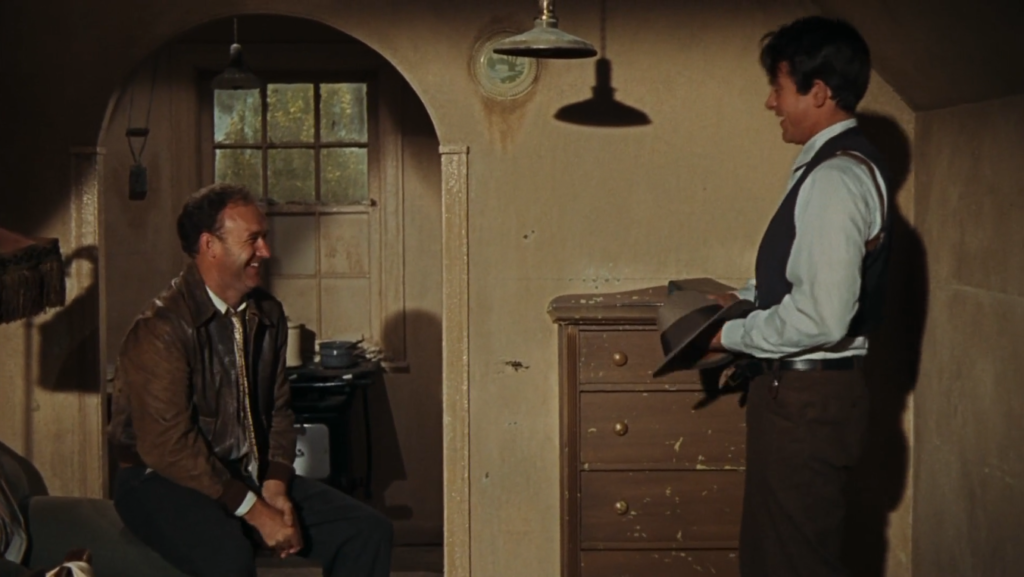
The men of Bonnie and Clyde are men of action, though not entirely typical. Clyde introduces Bonnie to the world of crime, teaches her how to shoot, takes charge in situations and is suave and confident, all quite typical of a male character. However, Clyde is very supportive of Bonnie through the film, defending her poetry to Buck, becomes very aggressive to Hamer when he spits on her and lets her see her family even though it could be dangerous to the gang. Clyde is also used as comedy through his masculinity as well, such as when he bangs his head on the car door when leaving the car, or when Bonnie laughs at him for trying to rob a bank that went out of business, and even his first robbery is a result of trying to show off to Bonnie. His brother Buck is similar, falling into aspects typical of a male character, leading action and being a more obvious comic relief character, telling bad jokes and roughhousing with Clyde when they first meet, but he also sticks up for Blanche, defending her when Bonnie snaps at her and speaking up for her when she asks for a share of the money.
Authority Figures
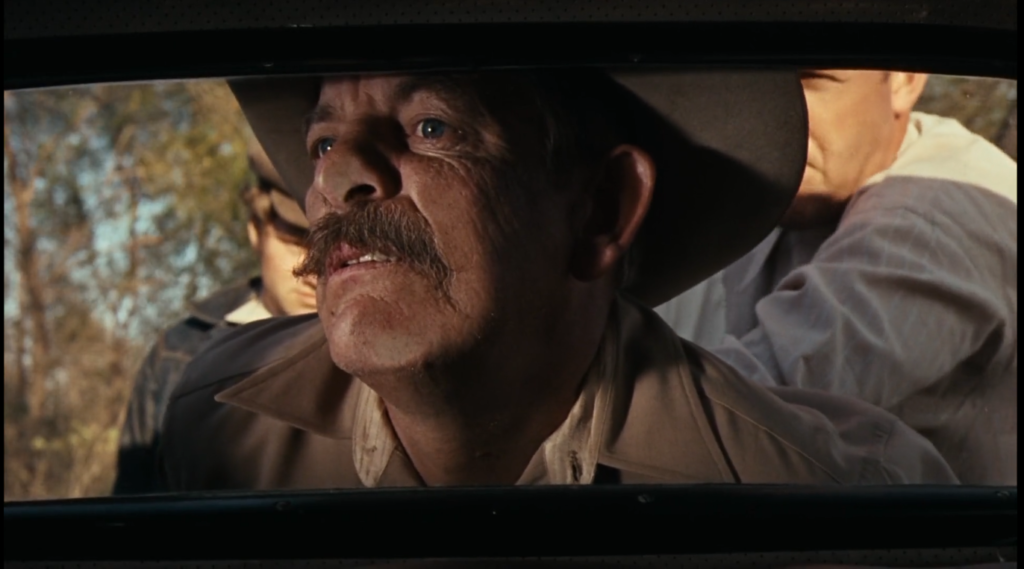
The authority figures in the film are the antagonists, menacing the Barrow Gang, being stuck up and cruel. Frank Hamer, the main antagonist of the film, is presented as a mean, tough man, chasing the Barrow Gang mainly for petty revenge. He mistreats a newly blinded Blanche, getting information out of her and then leaving the room without telling her, leaving her talking to no one. He uses people, spits on Bonnie, is very aggressive and overkills Bonnie and Clyde greatly. The authority figures in Bonnie And Clyde are villainous and aggressive, presented in a very negative light.
People Of Colour
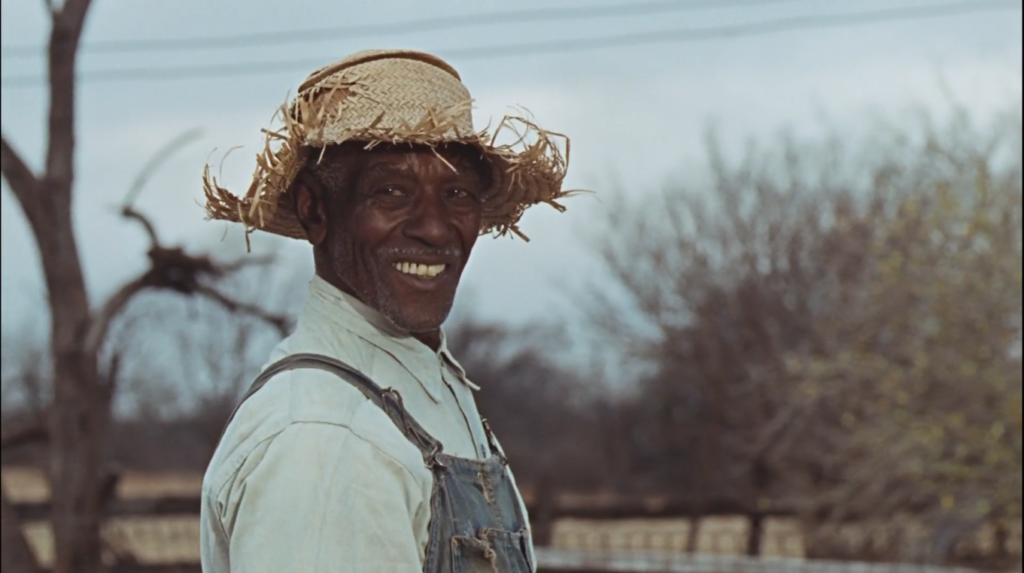
There are barely any people of colour in the film, and the ones that re in the film are not given much screentime. The most notable representation of people of colour is when Clyde gives a farmer his gun to let him shoot his repossessed house, which the farmer then gives to his black farmhand, who also shoots the house. The person is treated with mild respect, but is still depicted in a stereotypical way as a manual labourer and doesn’t have any lines.
Working Class Americans
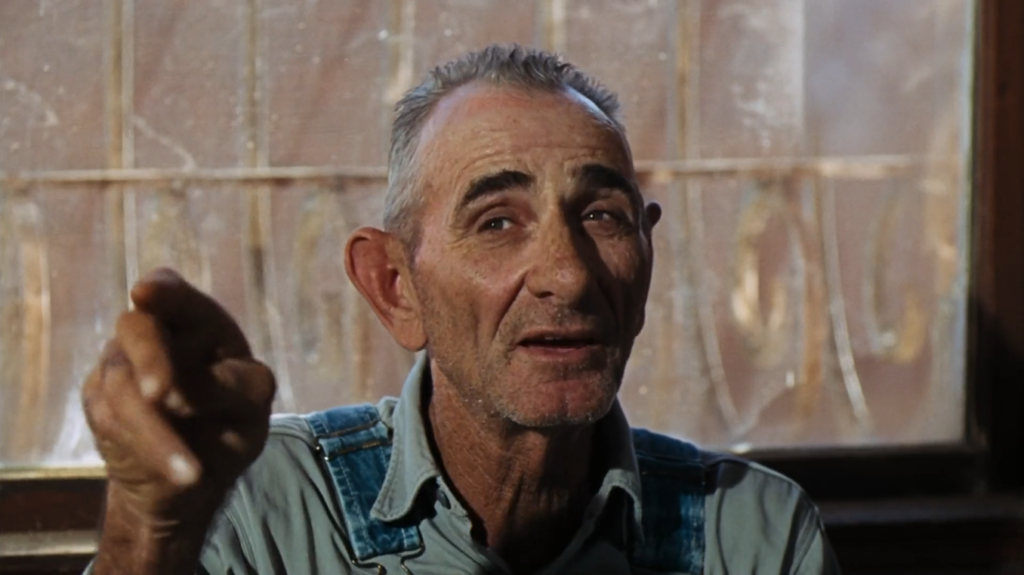
The working class of America are presented as sympathetic. The main characters Bonnie and Clyde are members of the working class, Bonnie being a waitress and Clyde was a petty thief. The gang’s motivations are to rebel against the upper classes, showing disdain for authority and those with wealth and showing sympathy to those in the lower classes. During a robbery, they let a man keep money he was withdrawing from the bank before running away, and the man tells the press that that the Barrow Gang are all right with him. Bonnie and Clyde create solidarity among the lower classes and the less fortunate by rebelling against the status quo.
Political and Social Context
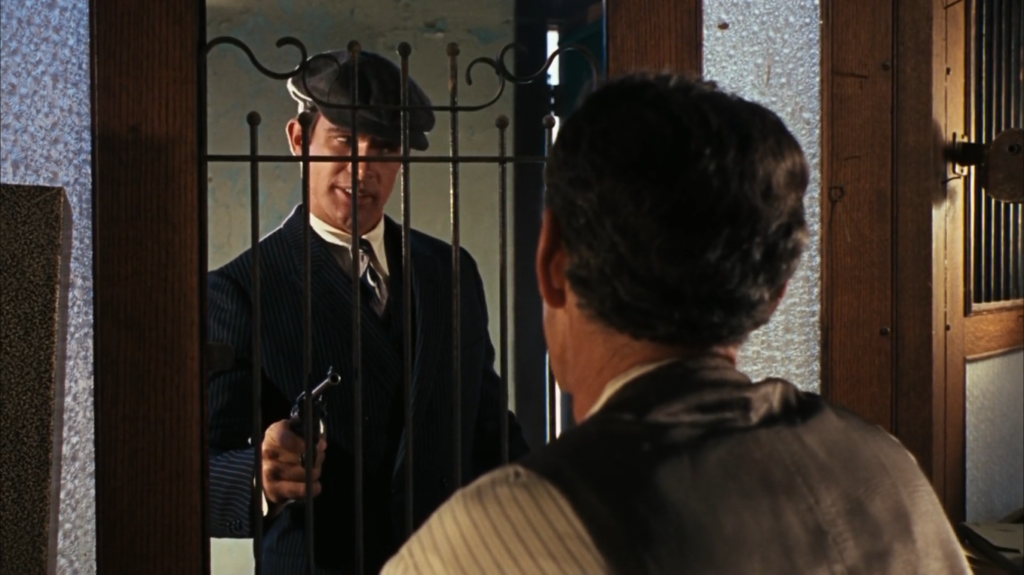
Bonnie and Clyde takes place in the 1930’s, a time of struggle. The Great Depression and the Wall Street Crash serve as the main backdrop behind the actions of the main characters. The Great Depression was an economic crash in the 30’s that caused high levels of unemployment and poverty. People lost a lot of money and it was a time of misfortune and loss. The film shows Bonnie and Clyde robbing banks in retaliation to the poor losing houses and items to repossessions, showing them in a heroic light as they fight against authority and the effects of the Great Depression.
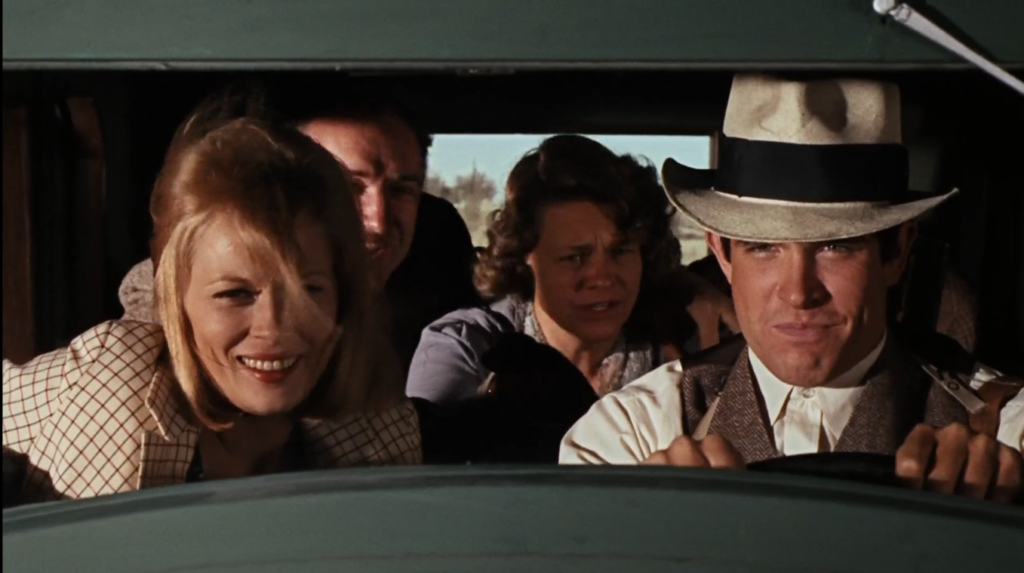
The 1960s – when the movie was filmed – was also a time of social turmoil. Near the start of the decade, president John F Kennedy was assassinated. Before this, he was leading the USA in dealing with the Cuban Missile Crisis, part of the Cold War, which garnered a lot of fear in the American population. JFK was becoming disliked among the American population due to his poor handling of the Vietnam war, which led to a time of social revolution where people began campaigning for peace and freedom. Counterculture became popular in America, as the population disagreed with the current government and didn’t want any more conflict or war. Dislike of authority grew. People campaigned for progression and liberation, wanting equality for women and minorities. These counterculture attitudes also entailed a sexual revolution. This disdain for authority and call for revolution probably influenced the themes of Bonnie And Clyde, such as giving strength to the female characters, rebellion towards authority and liberation.